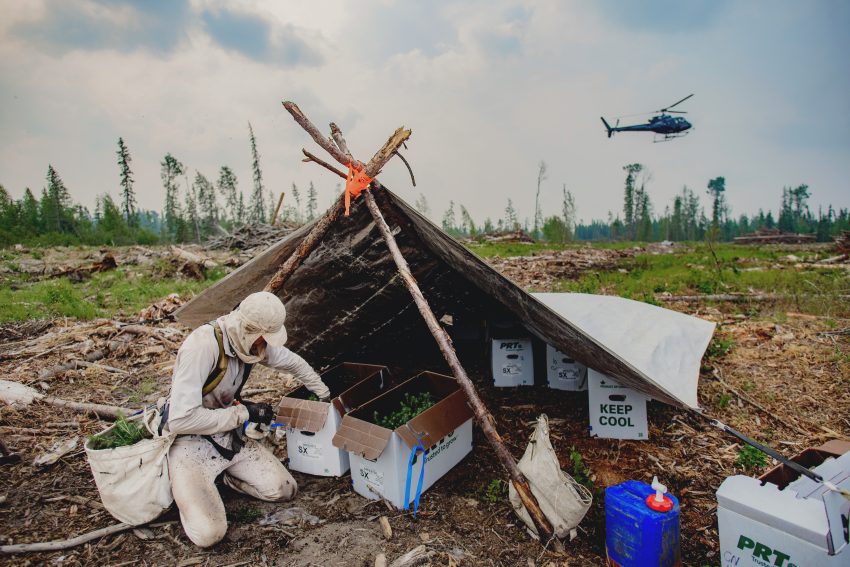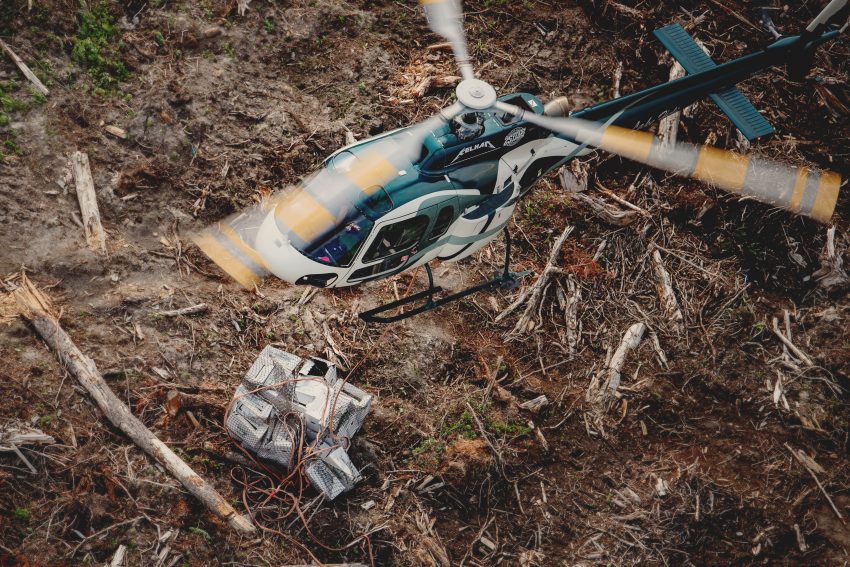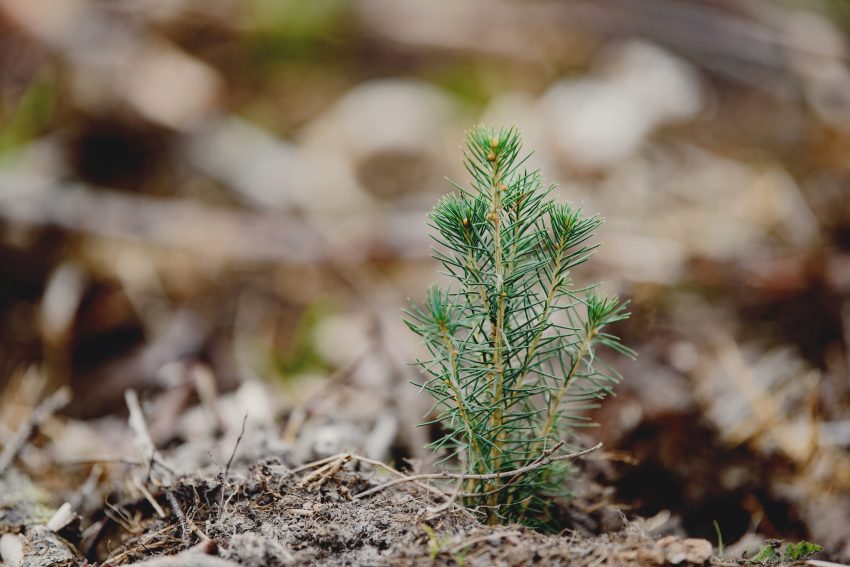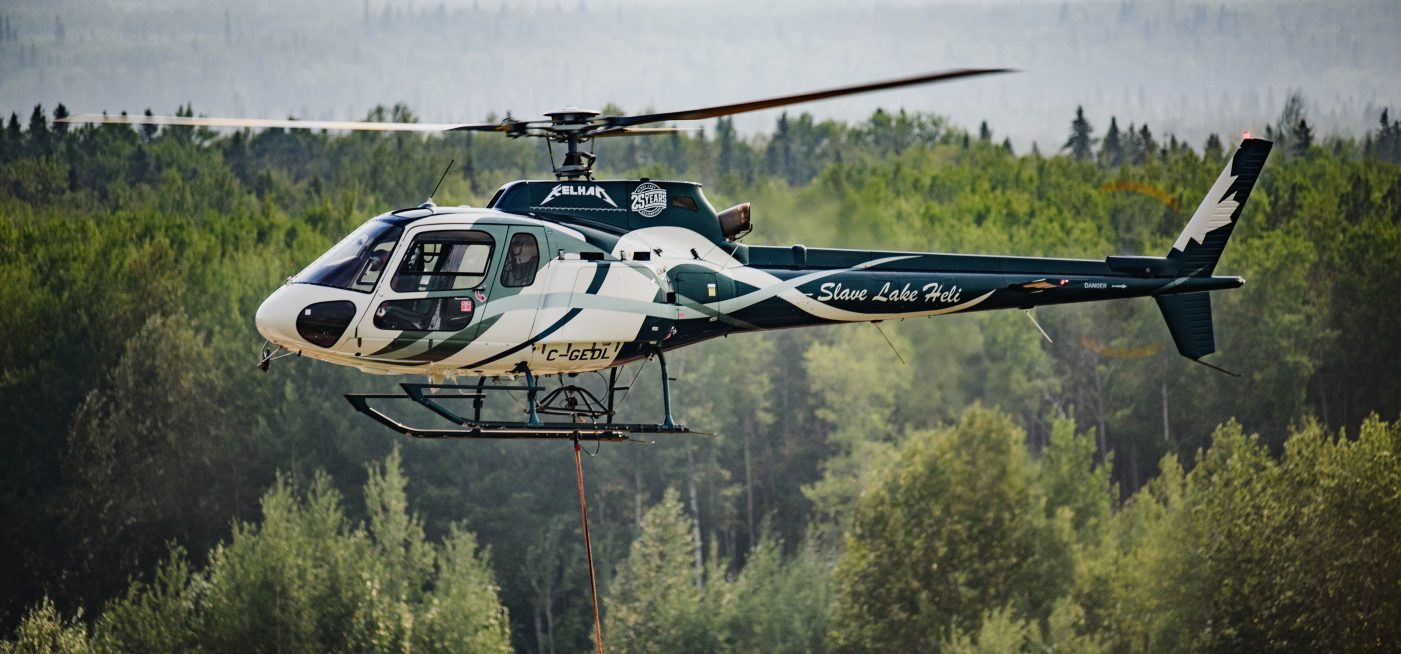In Alberta, Slave Lake Helicopters, with their fleet of H125 helicopters, is playing a key role in reforestation by transporting tree planters, seedlings, and machinery to some of the province’s most remote and challenging areas, leaving a lasting impact on both the environment and the communities they support.
Recently, in their 26th year of operation, the company achieved a major milestone, the planting of their 200 millionth seedling in the boreal forests of Alberta.

The impact of 200 million trees
The planting of 200 million trees is more than just a number; it represents a significant contribution to environmental protection. The success of the company is based on strong and long-lasting partnerships within the forestry sector in Alberta, and relies on working closely with the five forestry mills in the area, each of which has a duty and responsibility to replant trees after they are harvested. Around 2-4 trees are planted for every one that is cut down.
Each tree helps to combat climate change, restore ecosystems, and provide habitat for wildlife, so it is essential that when they are cut down for forestry, they are replanted to maintain the important ecosystem. For George and Debbie Kelham, Owners and Operators of Slave Lake Helicopters, this work is a labour of love. “We feel that we’re doing a lot of good,” George Kelham says. “Planting trees is part of the equation that is required to keep the globe at a minimal level of pollution. The trees do the ecological system a big favour. Right now we’re at a pace of about 15 million trees planted per year.”

Airbus H125: the helicopter of choice for tree planting and wildfire fighting
The success of the milestone is due in large part to the advanced capabilities of Airbus Helicopters’ H125. These helicopters are not just workhorses; they are precision tools that are critical to the unique requirements of the mission.
“It is the helicopter of choice,” Kelham says. “It’ll sling the right amount of seedlings, it’ll move the right amount of people. Very minimal downtime, and the cost per tree is the lowest you can get it.”
The Airbus H125 is perfectly suited for the demanding environments where these reforestation efforts take place. Its powerful engine and exceptional manoeuvrability allow it to access the remote, rugged zones within forests that are designated for reforestation (commonly referred to as “blocks”) that are otherwise unreachable, making it an indispensable asset in the planting of trees.
Kelham credits the united front of skilled mechanics, experienced pilots, and quality equipment for putting Slave Lake Helicopters at the forefront of tree planting over the years, and the dedication of his team that has allowed them to be responsive to the needs of the mission.
“We are very proud of our pilots that make these landings in unprepared landing pads in the blocks, day in and day out, and the engineers that work whenever they can to keep these helicopters maintained,” Kelham says. He continues on to state that they have had no downtime from an Airbus product over their 26 years, further underscoring his confidence in Airbus and in his choice to operate a fleet of seven H125 helicopters. On average, Kelham estimates that they fly about 1,500 hours per year planting trees with their H125 helicopters.
Reforestation isn’t the only way the company contributes to environmental protection. The same helicopters that transport tree planters and seedlings into the wild also serve a critical role in fighting the wildfires that threaten those very ecosystems every year. Working closely with Alberta Wildfire, teams are on call and ready to quickly dispatch helicopters for wildfire suppression, carrying water to fight fires in areas unreachable by ground forces.
“These helicopters are the only way to get into some of these remote areas,” says Kelham. “Without them, both planting 200 million trees and responding to wildfires simply wouldn’t be possible.”

A bright future ahead
Looking to the future, Slave Lake Helicopters’ dedication to sustainability and protecting their community remains unwavering. With a clear purpose and a highly capable fleet, the company plans to continue leading reforestation efforts throughout Alberta. As they celebrate this remarkable achievement, Kelham and his team remain focused on their mission to protect and preserve Alberta’s forests. He hopes that soon, they’ll be marking their next major milestone – a quarter of a billion trees planted – just in time to celebrate their 30th anniversary of helicopter operations in Slave Lake, Alberta.

Planter 200 millions d’arbres avec l’Airbus H125
Alors que les incendies de forêt et l’exploitation forestière continuent d’éroder les vastes forêts du Canada, la nécessité d’un reboisement à grande échelle n’a jamais été aussi grande. Restaurer ces écosystèmes ne consiste pas seulement à planter des arbres, mais aussi à reconstruire les habitats, à stabiliser le climat et à protéger notre avenir. Mais ces zones sont souvent éloignées et difficiles d’accès, ce qui complique les efforts de reboisement . C’est là que les hélicoptères entrent en jeu.
En Alberta, Slave Lake Helicopters, avec sa flotte d’hélicoptères H125, joue un rôle clé dans le reboisement en transportant des planteurs d’arbres, des semis et des machines dans certaines des zones les plus reculées et les plus difficiles d’accès de la province, laissant un impact durable à la fois sur l’environnement et sur les communautés qu’ils soutiennent.
Récemment, au cours de sa 26e année d’activité, l’entreprise a franchi une étape importante en plantant son 200 millionième plant dans les forêts boréales de l’Alberta.
L’impact de 200 millions d’arbres
La réussite de l’entreprise repose sur des partenariats solides et durables au sein du secteur forestier de l’Alberta, et sur une collaboration étroite avec les cinq scieries de la région, chacune ayant le devoir et la responsabilité de replanter les arbres après leur récolte. Environ 2 à 4 arbres sont plantés pour chaque arbre abattu.
Chaque arbre contribue à lutter contre le changement climatique, à restaurer les écosystèmes et à fournir un habitat à la faune et à la flore. Il est donc essentiel que lorsqu’ils sont abattus pour l’exploitation forestière, ils soient replantés pour maintenir cet écosystème important. Pour George et Debbie Kelham, propriétaires et exploitants de Slave Lake Helicopters, ce travail est une véritable passion. « Nous avons le sentiment de faire beaucoup de bien », déclare George Kelham. « Planter des arbres fait partie de l’équation nécessaire pour maintenir la planète à un niveau de pollution minimal. Les arbres rendent un grand service au système écologique. Actuellement, nous en sommes à un rythme d’environ 15 millions d’arbres plantés par an ».
Airbus H125 : l’hélicoptère de choix pour la plantation d’arbres et la lutte contre les incendies de forêt
Le succès de cette étape est en grande partie dû aux capacités avancées du H125 d’Airbus Helicopters. Ces hélicoptères ne sont pas de simples engins de travail ; ce sont des outils de précision essentiels aux exigences uniques de la mission.
« C’est l’hélicoptère de prédilection », déclare M. Kelham. « Il peut transporter la bonne quantité de semis et le bon nombre de personnes. Le temps d’immobilisation est minime et le coût par arbre est le plus bas possible.
L’Airbus H125 est parfaitement adapté aux environnements exigeants dans lesquels se déroulent ces efforts de reboisement. Son moteur puissant et sa manœuvrabilité exceptionnelle lui permettent d’accéder aux zones reculées et accidentées des forêts désignées pour le reboisement (communément appelées « blocs ») qui sont autrement inaccessibles, ce qui en fait un atout indispensable pour la plantation d’arbres.
Kelham reconnaît que le front uni des mécaniciens qualifiés, des pilotes expérimentés et de l’équipement de qualité a permis à Slave Lake Helicopters d’être à l’avant-garde de la plantation d’arbres au fil des ans, et que le dévouement de son équipe lui a permis d’être réactive aux besoins de la mission.
« Nous sommes très fiers de nos pilotes qui, jour après jour, effectuent ces atterrissages sur des zones non préparées dans les blocs, ainsi que des ingénieurs qui travaillent chaque fois qu’ils le peuvent pour assurer la maintenance de ces hélicoptères », déclare M. Kelham. Il poursuit en affirmant qu’aucun produit Airbus n’a connu d’interruption de service au cours de ces 26 années, ce qui confirme sa confiance en Airbus et son choix d’exploiter une flotte de sept hélicoptères H125. En moyenne, Kelham estime qu’ils volent environ 1 500 heures par an pour planter des arbres avec leurs hélicoptères H125.
Le reboisement n’est pas le seul moyen pour l’entreprise de contribuer à la protection de l’environnement. Les mêmes hélicoptères qui transportent les planteurs d’arbres et les semis dans la nature jouent également un rôle essentiel dans la lutte contre les incendies de forêt qui menacent ces mêmes écosystèmes chaque année. En étroite collaboration avec Alberta Wildfire, des équipes sont prêtes à envoyer rapidement des hélicoptères pour éteindre les feux de forêt, en transportant de l’eau pour lutter contre les incendies dans les zones inaccessibles aux forces terrestres.
« Ces hélicoptères sont le seul moyen d’accéder à certaines de ces zones reculées », explique M. Kelham. « Sans eux, il serait impossible de planter 200 millions d’arbres et de lutter contre les incendies.
Un avenir radieux
En ce qui concerne l’avenir, le dévouement de Slave Lake Helicopters à la durabilité et à la protection de sa communauté reste inébranlable. Avec un objectif clair et une flotte très performante, l’entreprise prévoit de continuer à mener des efforts de reboisement dans toute l’Alberta. Alors qu’ils célèbrent cette réalisation remarquable, M. Kelham et son équipe restent concentrés sur leur mission de protéger et préserver les forêts de l’Alberta. Il espère qu’ils atteindront leur prochain grand jalon – un quart de milliard d’arbres plantés – juste à temps pour célébrer leur 30e anniversaire de l’exploitation des hélicoptères à Slave Lake, en Alberta.





